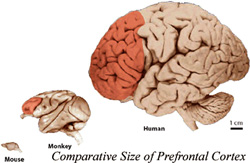 Most neuroscientists don't use human subjects, and many tend to forget this important point:
Most neuroscientists don't use human subjects, and many tend to forget this important point:
All neuroscience with non-human subjects is theoretical.
If the brain of a mouse is understood in exquisite detail, it is only relevant (outside veterinary medicine) in so far as it is relevant to human brains.
Similarly, if a computational model can illustrate an algorithm for storing knowledge in distributed units, it is only as relevant as it is similar to how humans store knowledge.
It follows from this point that there is a certain amount of uncertainty involved in any non-human research. An experiment can be brilliantly executed, but does it apply to humans?
Circumventing this uncertainty problem by looking directly at humans, another issue arises: Only non-invasive techniques can be used with humans, and those techniques tend to involve the most uncertainty.
For instance, fMRI is a non-invasive technique that can be used to measure brain processes in humans. However, it measures the oxygenation levels, which is only indirectly related to neural activity. Thus, unlike with animal models, measures of neuronal activity are surrounded by an extra layer of uncertainty in humans.
So, if you're a neuroscientist you have to "choose your poison": Either deal with the uncertainty of relevance to humans, or deal with the uncertainty of the processes underlying the measurable signals in humans.
The benefits of animal or computational modeling are obvious. You have exquisite control over the experimental situation, and fuller knowledge of the underlying processes because of invasive abilities.
The main benefit of human neuroscience, despite the uncertainty of the measures, arises from its direct relevance (we're all interested in human neuroscience, ultimately).
Also, animal neuroscience faces the problem of ballooning uncertainty as the behavior of interest becomes more complex and unique to humans (i.e., cognitive in nature). For instance, the best animal models for language are non-human primates and song birds. Can we really assume that these animal models perform the same kinds of processes I'm using right now to write this sentence? (I've never written that sentence before, and like most complex sentences, it's most likely never been written in the history of the universe.)
Another promising trend in human neuroscience is decreasing uncertainty of the experimental observations. Perhaps ironically, animal models are providing the means to understanding these non-invasive signals. For instance, monkey neurons have been recorded during non-invasive fMRI such that a relationship could be established.
Ultimately human and non-human neuroscience are complimentary. Ideas first formulated and operationalized with computational models have framed many human studies, facilitating discoveries. Similarly, animal models have allowed for discoveries dependent on invasive techniques, which were immediately applicable to humans (e.g., because of evolutionary conservation of certain cell types).
As human neuroscience methods become more powerful this will provide a chance to verify many long-standing findings in non-human neuroscience. As non-human neuroscience methods become more powerful they will provide sophisticated new theories to test in the future.
Together, the two approaches will continue to push the cutting edge of progress in neuroscience.
As scientists with a common goal of understanding how the human brain functions, those focusing on human and non-human neuroscience should respect each other's methodological approaches, integrating across them where possible in the name of progress.
-MC

As an interested observer, but non-neuroscientist, I am avidly following the advances in neuroscience and enjoying your posts tremendously. Thank you for them.
But I am a bit astonished by how little concern is given to the ethical issues of non-human subjects. It is known that monkeys have similar (homologous) neurological modules related to affect and emotion as humans (example: Jaak Panksepp’s Affective Neuroscience) , which necessarily implies that fear, pain, horror, grief and suffering are part of their cognitive world. Extrapolating that further makes it clear that some of modern neuro-scientific research on non-human primates is pretty close to torture.
Is there any discussion of this in the scientific community? Or are the gains offered so great they automatically squelch the difficult questions of renouncing animal research?
respects,
Jhave
Jhave,
Good to hear from you, and thank you for the feedback. I’m sure MC will respond shortly, but I’ll throw in my $0.02 here.
Actually the ethics of animal research are widely discussed and are of great concern. I should also mention that doctoral programs in neuroscience generally have a mandatory ethics requirement.
Although I don’t work with animals in my research, I understand from people who do that permission to do so depends on providing huge experiment protocols (hundreds of pages) that fully describe all the procedures and precautions taken for the well-being of the animals — these must be approved in their entirety before any funding for the research can be granted.
In contrast, the protocols for human research are a tiny fraction of that size.
-PL